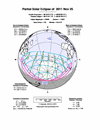- - text and links as of last publication - -
![]()
| CAUTION! OBSERVING A SUN ECLIPSE IS DANGEROUS AND MAY CAUSE IRREVERSIBLE EYE DAMAGE, UP TO BLINDNESS, ANNULAR AND PARTIAL ECLIPSES INCLUDED! Observing a Sun eclipse necessitates DEDICATED SAFE TECHNIQUES! |
Here we come with the last partial solar eclipse of the year, and the last solar! Antarctica is at the middle of the scene, with southernmost South Africa or Tasmania and New Zealand concerned. People in the stations of Antarctica will have the midnight involved as with, a magnitude of 0,905 at greatest that eclipse is the largest partial solar eclipse this year. A partial solar eclipse occurs when neither the 'umbra' nor the 'antumbra' of the eclipse touches Earth in any place as the 'penumbra' does, only. Anywhere in the area of a partial solar eclipse, observers are treated with a Sun indented by the dark disk of the Moon. The umbral shadow is passing just 206 miles (330 km) above the Earth's surface! for more about the solar eclipses, theoretically, see our tutorial "Sun Eclipses"
Eclipse's greatest is occurring at 06:20:16 UT and the more towards the southern pole, the more the Sun indented by the disk of Moon. The inhabited areas concerned by that eclipse have their most percentage of the Sun occulted in New Zealand as the eclipse occurs late, just above the horizon by sunset, with about 30 percent as the indentation might be difficultly observable in South Africa or Tasmania
 | The November 25th, 2011 Partial Solar Eclipse as it will look like from southern New Zealand. picture site 'Amateur Astronomy', based on Stellarium |
Eclipse's main data are the following (data as of November 2010, F. Espenak, NASA/GSFC). The Moon's apparent diameter will be of 33' 5.2", compared to the Sun's 32' 24.2". for more about how to observe a solar eclipse, see our tutorial "Observing a Sun Eclipse ":
- greatest eclipse: 06:20:16.6 UT
- eclipse magnitude (fraction of the Sun's diameter obscured by the Moon at greatest eclipse): 0.9046
- P1 to P4 (moments of first-last external-internal tangency of the penumbra with Earth's limb; practically these are the moments of the eclipse for the places where the eclipse is partial); in UT: P1 at 04:23:15.5, P2 at 08:17:15.6 (no P2 nor P3 times as the cone of the penumbra is not entirely contained upon Earth's disk)
 | see a map for the November 25th, 2011 Partial Solar Eclipse. map courtesy Fred Espenak - NASA/GSFC |
. for more about this eclipse and for more about solar and lunar eclipses generally, you may see at Fred Espenak's NASA's eclipse website
Observation Reports: no special report was made about that eclipse
Website Manager: G. Guichard, site 'Amateur Astronomy,' http://stars5.6te.net. Page Editor: G. Guichard. last edited: 1/1/2011. contact us at ggwebsites@outlook.com